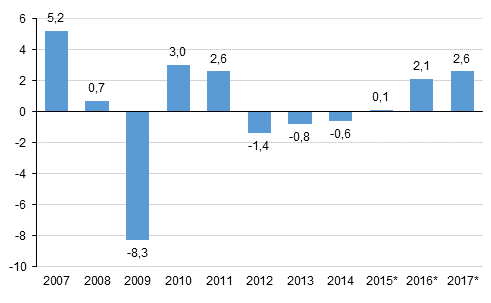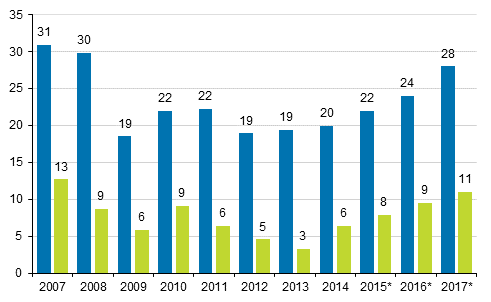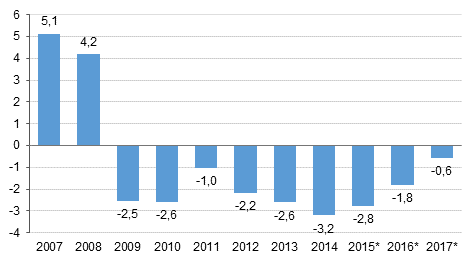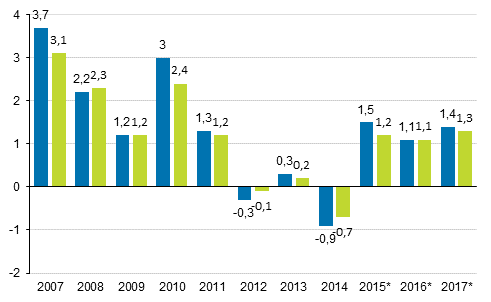1. Gross domestic product grew by 2.6 per cent in 2017
The volume of GDP grew by 2.6 per cent in 2017. The growth rate became slightly revised from the data published in early March (was 3.0 per cent). Last year, GDP that describes the output of the national economy stood at EUR 224 billion.
Figure 1. Annual change in the volume of gross domestic product, per cent (The figure was corrected on 29 March 2018)

The demand of the national economy went up by 3.6 per cent last year. Demand was particularly boosted by growth in investments and increased exports. Investments were 6.3 per cent higher than one year previously. The volume of private consumption went up by 1.6 per cent and public consumption by 1.3 per cent. The volume of exports grew by 7.8 per cent and that of imports by 3.5 per cent.
1.1 National income increased in real terms
Net national income grew by 4.4 per cent in nominal terms but by 3.3 per cent in real terms last year because the terms of trade weakened. National income per capita was EUR 33,600. Finland's gross national income amounted to EUR 226 billion last year. Gross national income grew by 2.7 per cent in real terms.
Households’ wage and salary income went up by 2.6 per cent and employers’ social insurance contributions declined by 5.4 per cent. In all, the share of compensation of employees in national income was 57.0 per cent, as against 59.0 per cent in the year before. Property and entrepreneurial income in the national economy went up by good 14 per cent and their share of the national income rose to 27.4 per cent.
1.2 Enterprises' financial position improved
Non-financial corporations' operating surplus describing profits from their actual operations went up by as much as 17.5 per cent from the previous year. Non-financial corporations’ entrepreneurial income increased by only 10 per cent as property income received by non-financial corporations decreased. Entrepreneurial income also takes into consideration property income and paid interests and rents, and corresponds roughly with profit before payment of taxes and dividends.
Figure 2. Non-financial corporations, operating profit from the operations proper before payment of taxes and dividends, etc. (= operating surplus, left column) and after (= net saving, right column), EUR billion

Non-financial corporations paid 27 per cent more direct taxes last year than in the previous year. Non-financial corporations are estimated to have paid six per cent less dividends. Non-financial corporations’ net lending, or financial position, showed a surplus of EUR 8.4 billion, the surplus in the previous year was slightly smaller.
The financial position of financial and insurance corporations showed a surplus of EUR one billion while it was EUR 0.3 billion in deficit in the previous year. Financial corporations’ interest income (financial intermediation services indirectly measured) grew slightly and commission income increased by good two per cent.
Because the intermediate consumption of financial and insurance corporations was exceptionally large in 2016, intermediate consumption decreased considerably from 2017 and the operating surplus grew by more than 30 per cent.
1.3 General government deficit 0.6 per cent of GDP
The financial position of general government, i.e. net lending, showed a deficit of 1.3 EUR one billion, while the deficit was EUR 3.9 billion in the previous year. The deficit amounted to 0.6 per cent relative to GDP. In the previous year, the deficit amounted to 1.8 per cent of GDP.
Last year, the financial position of central government showed a notable deficit for the ninth successive year. The deficit was, however, clearly smaller than in the preceding eight years. The deficit (net borrowing) was EUR 3.8 billion, while one year before it was EUR 5.8 billion.
State revenues from taxes went up by 4.0 per cent. Revenues from income tax from corporations, the vehicle tax and car tax grew most. Tax revenues from excise duty on confectionery, ice cream and non-alcoholic beverages (the excise duty on sweets was removed) and from the asset transfer tax were slightly lower than in the previous year.
Income transfers to local government (municipalities and joint municipal authorities, etc.) incl. repayments of value added tax declined by 3.8 per cent. This was affected, for example, by basic social assistance being transferred from municipalities to the Social Insurance Institution. Current transfers to social security funds grew by 10.5 per cent. In nominal terms, central government's consumption expenditure decreased by two per cent and gross fixed capital formation by 1.9 per cent.
The deficit or net borrowing of local government was EUR 0.2 billion, having been EUR one billion in the year before. Tax revenues received by municipalities went up by 3.8 per cent. Final consumption expenditure went up by 0.1 per cent in nominal terms, and gross fixed capital formation is estimated to have grown by 0.9 per cent.
The surplus of employment pension schemes decreased slightly from the previous year. The surplus was now EUR 2.1 billion, while one year before it was EUR 2.4 billion. The surplus does not include holding gains in assets. Revenues from pension contributions grew by 1.7 per cent, and employment pensions paid by employment pension funds by three per cent. Slightly fewer persons retired on earnings-related pension than in the year before.
Other social security funds were EUR 0.7 billion in surplus mainly due to an increase in received income transfers from the state. Basic social assistance was transferred from municipalities to the Social Insurance Institution from the beginning of 2017.
Figure 3. General government surplus / deficit relative to GDP, per cent (The figure was corrected on 29 March 2018)

The so-called EDP debt, or consolidated gross debt, of general government went up by good one billion to EUR 137 billion. The debt was 61.4 per cent relative to gross domestic product at the end of 2017. Statistics Finland will publish the deficit and debt data to be reported to Eurostat on 29 March 2018. The deficit and debt data published here may become revised in that connection.
General government's share of the gross value added was 18.6 per cent, having been 19.7 per cent one year earlier. The proportion of total public expenditure to GDP dropped to 53.7 per cent. In the previous year, the proportion was 56.0 per cent. Total public expenditure includes a notable amount of internal public sector expenses that are included in the calculations twice.
The tax ratio, or the ratio of taxes and statutory social security contributions to GDP, was 43.3 per cent last year. The tax ratio decreased by 0.7 percentage points from the previous year.
1.4 Households’ real income grew by 1.4 per cent
In 2017, households’ disposable income increased by 2.3 per cent in nominal terms and by 1.4 per cent in real terms. Households’ adjusted disposable income increased by 1.7 per cent in nominal terms and by 1.3 per cent in real terms. Adjusted income also takes into consideration welfare services, i.e. the individual services that general government and organisations produce for households, such as educational, health and social services.
Figure 4. Annual change in households’ disposable real income (left column) and household's adjusted real income (right column), per cent

Wages and salaries received by households went up by 2.6 per cent and social benefits by 0.3 per cent. The wages and salaries sum went up due to the risen level of earnings and improvement in employment. The rise in social benefits was curbed, for example, by slightly fewer persons retiring on earnings-related pension than in the year before. Households’ property and entrepreneurial income went up by 1.8 per cent.
Direct taxes paid by households increased by 0.8 per cent. Final consumption expenditure grew by 2.6 per cent in nominal terms. The savings rate, i.e. the ratio of savings to disposable income, was -0.9 per cent, being negative for the second year in a row.
Households’ fixed investments primarily in dwellings increased by 8.9 per cent in nominal terms. The financial position of households showed a deficit of EUR 7.8 billion, while the deficit in the previous year was EUR 6.1 billion.
Households' indebtedness ratio grew further and stood at 128.2 per cent at the end of 2017, which was 1.8 percentage points higher than one year earlier. The indebtedness ratio expresses the ratio between the loans and annual disposable net income in accordance with financial accounts. Annual financial accounts data on the situation at the end of the year are preliminary assessments.
1.5 Current account in surplus
Finland's current account turned into surplus last year and amounted to EUR 1.6 billion. When imports are also valued at FOB price (at the border of the exporting country) and not at CIF price (at the border of the importing country), as is done in the foreign trade statistics of Finnish Customs, the goods trade showed a surplus of EUR 2.2 billion. However, the balance of services trade showed a deficit of EUR 1.2 billion.
In total, EUR two billion more property income was received from the rest of the world than was paid there. The current transfer outflow was EUR two billion higher than the received income transfers.
The data on property items and international trade in services are very preliminary.
The recording of factoryless goods production was changed in the National Accounts one year ago. From the statistical reference year 2014 onwards, the margin of factoryless goods production or net sales from abroad to abroad is recorded in goods exports instead of service exports (see Section: Changes in these statistics).Earlier years will be changed in July 2018
1.6 Next revisions in May and July 2018
National accounts data concerning the first quarter of 2018 will be released on 31 May 2018. National Accounts for 2017 with more detailed data contents will be released on 12 July 2018.
These preliminary data are based on the information on economic development available by 8 March 2018. More information on the national accounts methods can be found on Statistics Finland’s website at: http://tilastokeskus.fi/til/vtp/men_en.html
Source: National Accounts 2017, preliminary data. Statistics Finland
Inquiries: Tuomas Rothovius 029 551 3360, Pekka Tamminen 029 551 2460, kansantalous@stat.fi
Director in charge: Ville Vertanen
Updated 16.3.2018
Official Statistics of Finland (OSF):
Annual national accounts [e-publication].
ISSN=1798-0623. 2017,
1. Gross domestic product grew by 2.6 per cent in 2017
. Helsinki: Statistics Finland [referred: 20.4.2025].
Access method: http://stat.fi/til/vtp/2017/vtp_2017_2018-03-16_kat_001_en.html

